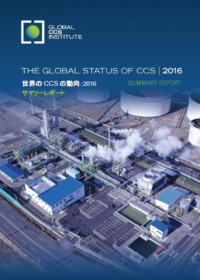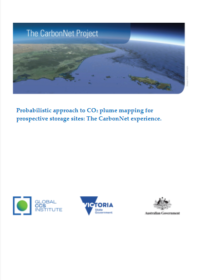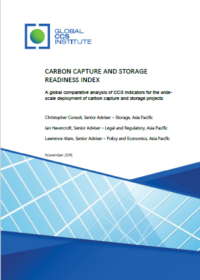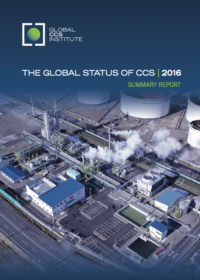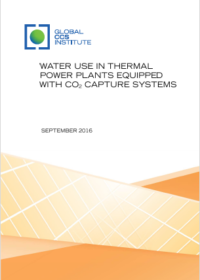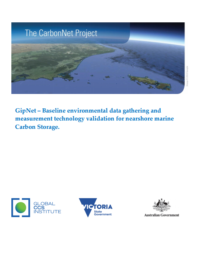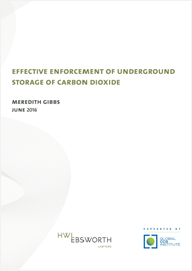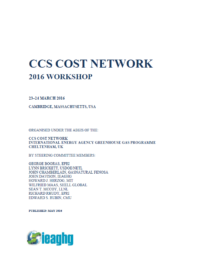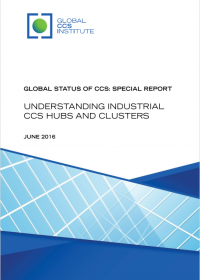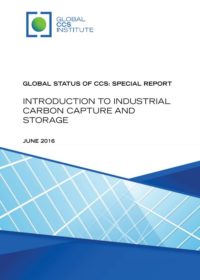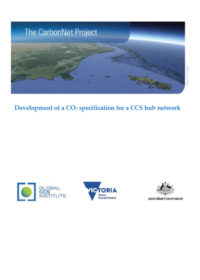Resources
Publications
Our publications, reports and research library hosts over 500 specialist reports and research papers on all topics associated with CCS.
View our Publication Library Disclaimer.
Filter by
本年度のサマリーレポートは、2016年にCCS主要プロジェクトにおいて達成された業績と2016年に操業を開始また操業開始間近の主要プロジェクトにフォーカスをしています。本レポートと同時に刊行された「世界のCCSの動向:2016」は、5章から成り、このサマリーリポートの内容を含むより詳細な情報が網羅されています。
Disclaimer
The content within the Global CCS Institute Publications, Reports and Research Library is provided for information purposes only. We make every effort and take reasonable care to keep the content of this section up-to-date and error-free. However, we make no claim as to its accuracy, currency or reliability.
Content and material featured within this section of our website includes reports and research published by third parties. The content and material may include opinions and recommendations of third parties that do not reflect those held by the Global CCS Institute.
Probabilistic approach to CO2 plume mapping for prospective storage sites: The CarbonNet experience
30th November 2016
Topic(s): CO2 storage
The Global CCS Institute is supporting the development of the CarbonNet Project through a series of reports and enable the sharing of knowledge throughout its development. The CarbonNet Project is in its feasibility phase and planning the development of a hub-based network that will centre on a large capacity pipeline to deep, secure storage sites, offshore Victoria, Australia. The Project is planning to store up to 125 million tonnes over 25 years in the Gippsland Basin.
The Gippsland Basin holds world class geologic formations for CO2 storage with multiple 100-150m thick, multi-Darcy, clean quartz-dominated sands, overlain by thick caprocks. The ideal geologic conditions means that the CO2 will be mobile and enable accurate plume prediction modelling which is critical during this phase of CarbonNet's site characterisation. Moreover, in Australia storage regulations require plume path predictions with more than 10 per cent probability, that is 90% confidence of the CO2 plume's movement throughout the project’s lifecycle. Because of the petroleum industry’s decades of experience in modelling and probabilistic analysis, CarbonNet has been able to adapt this expertise for CO2 storage modelling in the Gippsland Basin.
The modelling focussed on a large anticlinal structure in the near shore Gippsland Basin, with an injection point down dip from the crest of the structure. The modelling and probabilistic analysis found that the variations in input data for porosity, permeability and residual gas saturation strongly affect the horizontal and lateral movement of the plume in the formations. The simulation modelling was completed over seven time frames from 10 years through to 300 years after injection commences. The analysis found that after the injection of 125 million tonnes, the CO2 plume migrated into the anticlinal structure but never moved outside the structure. CarbonNet's CO2 plume modelling methodology enables a quantified plume path uncertainty analysis both laterally (i.e. map view) and vertical extent (cross-section), offering 3D understanding of plume containment. This report confirms that containment can be demonstrated with an appropriate high level of regulatory and public confidence.
Disclaimer
The content within the Global CCS Institute Publications, Reports and Research Library is provided for information purposes only. We make every effort and take reasonable care to keep the content of this section up-to-date and error-free. However, we make no claim as to its accuracy, currency or reliability.
Content and material featured within this section of our website includes reports and research published by third parties. The content and material may include opinions and recommendations of third parties that do not reflect those held by the Global CCS Institute.
Global CCS Institute CCS readiness Index
17th November 2016
Topic(s): Carbon capture use and storage (CCUS)
Carbon capture and storage (CCS) is critical for meeting international climate change targets, and therefore deployment must be both rapid and global. To date, deployment has been limited to only a few countries and industries, with several factors slowing further progress.
The Global CCS Institute (Institute) has developed a ‘CCS Readiness Index’ (CCS Index) which quantifies these factors, based on assessment criteria across four indicators — inherent interest, policy, legal and regulatory (legal) and storage — which reflect major barriers or enablers for the deployment of CCS.
Disclaimer
The content within the Global CCS Institute Publications, Reports and Research Library is provided for information purposes only. We make every effort and take reasonable care to keep the content of this section up-to-date and error-free. However, we make no claim as to its accuracy, currency or reliability.
Content and material featured within this section of our website includes reports and research published by third parties. The content and material may include opinions and recommendations of third parties that do not reflect those held by the Global CCS Institute.
The Global Status of CCS: 2016 Summary Report
15th November 2016
Topic(s): Carbon capture use and storage (CCUS)
The Global Status of CCS: 2016 highlights a number of significant operational milestones reached in 2016 and key projects that have either entered operation in 2016, or are very close to commencing operation. The Global Status of CCS: 2016 is comprised of five unique publications including a Summary Report available to the public and a series of reports developed exclusively for Institute Members.
Disclaimer
The content within the Global CCS Institute Publications, Reports and Research Library is provided for information purposes only. We make every effort and take reasonable care to keep the content of this section up-to-date and error-free. However, we make no claim as to its accuracy, currency or reliability.
Content and material featured within this section of our website includes reports and research published by third parties. The content and material may include opinions and recommendations of third parties that do not reflect those held by the Global CCS Institute.
CCS education in developing countries – A Global CCS Institute guidance paper
11th October 2016
Topic(s): Public engagement
Education has long been recognised as a critical component in understanding how science, society, and adaptation influence thinking about issues impacting our climate. As an emerging technology with an important role to play in shaping our low carbon energy future, carbon capture and storage (CCS) plays a role in our teaching around these topics in both developed and developing countries.
Yet, past research from Dowd and Jeanneret and Corry and Reiner identified that CCS is poorly represented in school science curriculums, and teachers report a lack of confidence in teaching about the technology. To help address these and other issues around public engagement with CCS, the Institute works with educators and communication/engagement staff around the world to showcase and share best practice, and support the adaptation of the Institute’s own CO2degrees Education program.
This short guidance paper is a welcome contribution to the Institute’s education resources. In it, Geochemist and renowned CCS education professional Sallie Greenberg, PhD explores the key lessons from past CCS initiatives and the general education literature, before highlighting areas of commonality and potential areas of challenge when delivering education initiatives in developing countries. The Paper then uses a comprehensive case study on the work of the Stakeholder Engagement Team at the South African Centre for CCS (SACCCS) in order to bring some of these examples and learnings to life.
Disclaimer
The content within the Global CCS Institute Publications, Reports and Research Library is provided for information purposes only. We make every effort and take reasonable care to keep the content of this section up-to-date and error-free. However, we make no claim as to its accuracy, currency or reliability.
Content and material featured within this section of our website includes reports and research published by third parties. The content and material may include opinions and recommendations of third parties that do not reflect those held by the Global CCS Institute.
Water use in thermal power plants equipped with CO2 capture systems
28th September 2016
Topic(s): CO2 capture
Addition of a CO2 capture system to an existing power station has some impact on water consumption. CO2 capture systems require additional water for cooling and process make-up, which can be of concern, particularly in areas of water scarcity. During the past decade, a number of relevant studies have been published that estimate the increase in water use when a capture system is added to Pulverised Coal (PC), Natural Gas Combined Cycle (NGCC) and Integrated Gasifier Combined Cycle (IGCC) power production facility.
The report, authored by the Institute’s capture experts Guido Magneschi, Ron Munson and Tony Zhang, provides insights about how adding a CO2 capture system to a power plant impacts the volume of water withdrawn and consumed. The results of this analysis serve to dispel myths about the use of water in CCS systems. Specifically, they challenge the misleading assertion that CCS systems will double water consumption, which is often reported in papers and articles.
On the contrary, analyses of available data indicate that for power plants using wet-recirculating cooling systems, the increase in actual water consumed varies from approximately 20 per cent to 60 per cent, depending on the capture technology. For once-through cooling systems the increase can be negligible, or even negative when water recovery options are implemented. Water use estimates cannot be generalised, and are very dependent on the power plant type, the CO2 capture technology and the cooling system used.
Disclaimer
The content within the Global CCS Institute Publications, Reports and Research Library is provided for information purposes only. We make every effort and take reasonable care to keep the content of this section up-to-date and error-free. However, we make no claim as to its accuracy, currency or reliability.
Content and material featured within this section of our website includes reports and research published by third parties. The content and material may include opinions and recommendations of third parties that do not reflect those held by the Global CCS Institute.
GipNet – Baseline environmental data gathering and measurement technology validation for nearshore marine Carbon Storage
22nd August 2016
Topic(s): CO2 storage, CO2 transport
Disclaimer
The content within the Global CCS Institute Publications, Reports and Research Library is provided for information purposes only. We make every effort and take reasonable care to keep the content of this section up-to-date and error-free. However, we make no claim as to its accuracy, currency or reliability.
Content and material featured within this section of our website includes reports and research published by third parties. The content and material may include opinions and recommendations of third parties that do not reflect those held by the Global CCS Institute.
Effective enforcement of underground storage of carbon dioxide
5th August 2016
Topic(s): CO2 storage, Policy law and regulation
The perception of an effective enforcement regime that ensures the secure and safe storage of CO2 in underground geologic formations will be crucial in increasing public and industry confidence in carbon capture and storage (CCS) as a viable low-carbon technology.
An effective enforcement regime for underground storage of CO2 has the following key features:
- Comprehensive obligations that address the key risks of underground storage of CO2
- Comprehensive monitoring and verification (M&V) requirements, including baseline monitoring, M&V obligations during the injection phase and M&V obligations post-injection
- Enforcement mechanisms that are risk-based, layered and flexible, grounded in science and fact-based decision-making, and include the ability to deal with 'serious situations' (such as unintended releases and CO2 not behaving as predicted)
- A clear allocation of roles and responsibilities for enforcement.
Disclaimer
The content within the Global CCS Institute Publications, Reports and Research Library is provided for information purposes only. We make every effort and take reasonable care to keep the content of this section up-to-date and error-free. However, we make no claim as to its accuracy, currency or reliability.
Content and material featured within this section of our website includes reports and research published by third parties. The content and material may include opinions and recommendations of third parties that do not reflect those held by the Global CCS Institute.
Proceedings from the 2016 CCS Costs Workshop
14th July 2016
Topic(s): Carbon capture use and storage (CCUS)
The fourth meeting of the CCS Cost Workshop (also known as the Expert Group on CCS Costs) was held on March 23‐24, 2016 at the Massachusetts Institute of Technology (MIT) in Cambridge, Massachusetts.This function is now designated as the CCS Cost Network under the auspices of the International Energy Agency Greenhouse Gas Programme.
Disclaimer
The content within the Global CCS Institute Publications, Reports and Research Library is provided for information purposes only. We make every effort and take reasonable care to keep the content of this section up-to-date and error-free. However, we make no claim as to its accuracy, currency or reliability.
Content and material featured within this section of our website includes reports and research published by third parties. The content and material may include opinions and recommendations of third parties that do not reflect those held by the Global CCS Institute.
Understanding industrial CCS hubs and clusters
28th June 2016
Organisation(s): Global CCS Institute
Topic(s): Hubs and Clusters, Industrial CCS
The technology components of carbon capture and storage (CCS) are already proven and in use across a variety of industries and applications.
In some instances, individual industrial facilities can capture millions of tonnes of carbon dioxide (CO2) each year. However, many industrial plants operate at much smaller scales, and as a result have lower overall emissions. While the combined level of emissions from a number of such smaller scale facilities can be significant, it may be uneconomic for any individual facility to consider application of the full CCS chain which includes capture, compression, transport and permanent storage of CO2.
One solution to this problem is clustering, in which several industrial facilities share CCS infrastructure and knowledge, and thus reduce their costs compared with each facility attempting to individually reduce emissions. This report provides an overview of the idea of clustering as applied to industrial CCS projects, and examines the conditions needed for its more widespread adoption.
Introduction to industrial carbon capture and storage
Carbon capture and storage, or CCS, is a process used to capture carbon dioxide gas (CO2) that is produced by power stations or other types of industrial facilities. To keep CO2 out of the atmosphere, it is captured from the power plant or industry, transported, and securely stored underground, permanently.
One of the major benefits of CCS as an emissions reduction technology is that it can be applied to different types of CO2 emissions sources, particularly those with very large volumes of emissions, such as power plants and some industrial facilities.
Importantly, CCS is a proven technology that is already in operation around the world, in a number of industrial sectors. These industrial applications are the main focus of this report, and some of them date back as far as the 1970s and 1980s.
Disclaimer
The content within the Global CCS Institute Publications, Reports and Research Library is provided for information purposes only. We make every effort and take reasonable care to keep the content of this section up-to-date and error-free. However, we make no claim as to its accuracy, currency or reliability.
Content and material featured within this section of our website includes reports and research published by third parties. The content and material may include opinions and recommendations of third parties that do not reflect those held by the Global CCS Institute.
The CarbonNet Project: development of a CO2 specification for a CCS hub network
25th May 2016
Topic(s): Carbon capture use and storage (CCUS), CO2 hubs, CO2 transport
The Global CCS Institute is supporting the development of the CarbonNet Project through a series of reports and enable the sharing of knowledge throughout its development. The CarbonNet Project, located in the Victoria, Australia is in its feasibility phase. It is planning the development of a hub-based network that will centre on a large capacity pipeline (up to 5 million tonnes per annum) to deep, secure storage sites in the offshore Gippsland Basin.
A critical aspect of hub-based network projects in general is the complex process of gathering multiple sources of CO2 (e.g. coal-fired power stations, natural gas processing, etc.), each with unique properties, into a single pipeline and into a storage site. This report explores the details of different specifications from the various potential capture methods and feedstock, which could come together and how that could impact the specifications of infrastructure and the storage site itself.
The report outlines the lower and upper bounds of the potential CO2 specifications a hub project could encounter and proposes technically achievable limitations on the whole of project chain. This includes source proponents’ requirement, pipeline integrity and composition, requirements of the storage site, as well as health, safety and environment factors. Finally, the report outlines the techno-economic trade-off between additional processing for the CO2 sources and the impact on transport and storage.
By undertaking these studies in the early phase of project development, barriers such as restrictive specifications can be minimised and this could reduce costs overall, whilst increasing the viability of the multi-user system- the key platform for any hub-based network project.
This report is a product of work undertaken by Parsons Brinckerhoff with inputs from the CarbonNet Project team.
Disclaimer
The content within the Global CCS Institute Publications, Reports and Research Library is provided for information purposes only. We make every effort and take reasonable care to keep the content of this section up-to-date and error-free. However, we make no claim as to its accuracy, currency or reliability.
Content and material featured within this section of our website includes reports and research published by third parties. The content and material may include opinions and recommendations of third parties that do not reflect those held by the Global CCS Institute.
